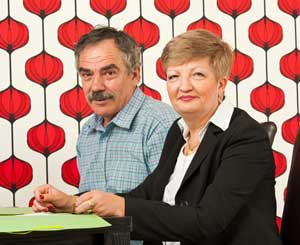 There will be times when you won’t get what you want or
need by asking. In these situations, you may have to advocate with government, a service provider or a member of your network in order to be successful. Advocacy involves a combination of education and persuasion.
There will be times when you won’t get what you want or
need by asking. In these situations, you may have to advocate with government, a service provider or a member of your network in order to be successful. Advocacy involves a combination of education and persuasion.
Education
Depending on the challenge, education may need to focus on one (or more) of the following three areas:
- Raising Awareness – Sometimes others are not aware that there is an issue and need to have it brought to their attention.
- Understanding the Issues – Sometimes others have heard of the issue, but do not understand the barriers and their impact. Or they may believe that a satisfactory solution already exists, when you know that it has not properly resolved the issue.
- Solving the Problem – Sometimes a solution (or program) exists, but rules, regulations or other barriers prevent you from accessing it. Sometimes there is a gap that needs to be filled.
Persuasion
Persuasion can operate at all three levels as well. For example, you may have to persuade people that:
- an issue is real
- barriers exist
- they need to be part of the solution
Resources
Local Community Resources contains information on many groups that can advocate for and with you.
The Pocket Guide to Advocacy (Alberta Association for Community Living) provides practical information on advocacy, particularly pages 17-30.
 When you are feeling desperate, it is very easy to treat advocacy
as though you were going into battle with an enemy. However, it is far more effective to view the other as a potential partner. In fact, most people (including government administrators and politicians) want to make a positive difference in people’s
lives. When they are made aware of the issue and understand its ramifications, they are likely to want to help you. Although it is tempting to remove yourself from the situation and tell others to “do something” to solve the problem, it is
in your best interest to stay engaged and work together to resolve the issue, so that the solution truly works for you.
When you are feeling desperate, it is very easy to treat advocacy
as though you were going into battle with an enemy. However, it is far more effective to view the other as a potential partner. In fact, most people (including government administrators and politicians) want to make a positive difference in people’s
lives. When they are made aware of the issue and understand its ramifications, they are likely to want to help you. Although it is tempting to remove yourself from the situation and tell others to “do something” to solve the problem, it is
in your best interest to stay engaged and work together to resolve the issue, so that the solution truly works for you.
When it comes to working with government departments or large organizations, those in charge of helping you may be hampered by existing policies that you are unaware of or don’t understand. The individuals you are dealing with in seeking a solution can help you learn about these policies. When they understand the situation, they may be able to point you to loopholes in the policies or exceptions that may apply, to other resources or to people with the power to make changes. They are more likely to make these extra efforts if you engage them as partners rather than as adversaries.
 The first rule of advocacy is that “no” is not a
final answer. Sometimes it is all that a particular person is allowed to say. Whether you are dealing with the government or a long-term care facility, someone has the authority to say “yes.” Finding a solution may require a change of plans, regulations
or laws. Or it may be much simpler. To get what you need, you may have to compromise from what works best to what works.
The first rule of advocacy is that “no” is not a
final answer. Sometimes it is all that a particular person is allowed to say. Whether you are dealing with the government or a long-term care facility, someone has the authority to say “yes.” Finding a solution may require a change of plans, regulations
or laws. Or it may be much simpler. To get what you need, you may have to compromise from what works best to what works.
 The second rule of advocacy is that the more effort
you put into making something happen, the more decision-makers will take you seriously. Signing a petition is a low-effort action and is unlikely to be taken seriously. Even petitions with thousands of signatures have very little impact because politicians
know that many people who signed the petition did not have strong feelings about the issue, and some may only have signed to oblige a friend. Petitions are mostly useful for raising awareness of an issue. On the other hand, a letter or e-mail that
is individually written—not a form letter—has more impact because more effort was required.
The second rule of advocacy is that the more effort
you put into making something happen, the more decision-makers will take you seriously. Signing a petition is a low-effort action and is unlikely to be taken seriously. Even petitions with thousands of signatures have very little impact because politicians
know that many people who signed the petition did not have strong feelings about the issue, and some may only have signed to oblige a friend. Petitions are mostly useful for raising awareness of an issue. On the other hand, a letter or e-mail that
is individually written—not a form letter—has more impact because more effort was required.
Letters to elected officials should always include a question so the official is required to respond. However, the response may be disappointing and unhelpful. For example, the response may say the letter has been forwarded to the Minister responsible for that issue. This happens when the letter writer did not identify the right party to receive the letter or when the letter was sent or copied to several elected officials (e.g., the head of the government, the Minister responsible and the writer’s elected representative). Although frustrating, the forwarding-to-higher-body response may be a sign that the elected official who received the letter is putting additional pressure on the decision-maker to respond. Generally speaking, letters are better for educating others to understand an issue than they are for solving problems.
 The third rule of advocacy is that
personal connections are the foundation of action. The saying, ”It’s not what you know, but who you know, that counts” is not the case. The truth is, you need to know both the what and the who. To have the most impact, you need to know
the issue and facts thoroughly as well as the decision-maker.
The third rule of advocacy is that
personal connections are the foundation of action. The saying, ”It’s not what you know, but who you know, that counts” is not the case. The truth is, you need to know both the what and the who. To have the most impact, you need to know
the issue and facts thoroughly as well as the decision-maker.
When you make the appointment to see the decision-maker, identify the issue you want to discuss. Before the meeting, plan what you will say and prepare answers for the questions you think the decision-maker may have. Research the facts, including statistics, the dates certain things took place, and who you have spoken to and what happened.
The advantage of a meeting over a letter is the opportunity for dialogue and building personal empathy and commitment. Dialogue allows you to ensure that the other person sees the big picture and understands the issues clearly. Empathy and commitment create a partnership between you and the other person aimed at solving the problem together.
 Not all meetings go well, but they
go better with a positive attitude toward taking action and forming partnerships. Good meetings typically have the following elements:
Not all meetings go well, but they
go better with a positive attitude toward taking action and forming partnerships. Good meetings typically have the following elements:
- Show appreciation for the opportunity to talk about your issue or situation.
- Focus on the topic; a meeting should never discuss more than two (preferably related) issues.
- Explain why the issue is important to you and your loved one, and describe its impact on your lives.
- Tell a story from your experience that illustrates the problem that needs to be fixed in order to bring the issue alive.
- If you know the standard solutions to the issue, describe what you have tried and identify the barriers you have encountered.
- Answer questions openly and honestly, even if the question seems intrusive; if you feel disrespected, calmly describe the feelings elicited by the question, using “I feel” language.
- If you don’t know or understand something, say so.
- State the change you think would help resolve the issue; be willing to consider alternatives.
- To show your commitment, offer to work together to find solutions that work.
- Ask what the follow-up to the meeting will involve, and when you can expect to hear from the person. This gives the other person enough time to take the next step. It also says you expect to stay involved because it is important to you.
- If appropriate, confirm what follow-up actions you will take and when the other person can expect to hear from you.
- Follow up and follow through.
“Many hands make light work.” If the issue you are dealing with is also a challenge for others, it is helpful to join forces to advocate for change and share the workload. There is also strength in numbers. A decision-maker is more likely to recognize the need for systemic action when faced with an organized group than with just one individual.